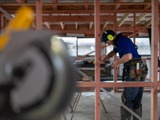Protective measures undertaken during a State of Emergency or Transition Period, such as notices (placards) that prohibit access, lose legal force when the State of Emergency ends.
Placards and other measures can be transitioned to notices under section 124 of the Building Act, but you can only use these provisions for buildings that are dangerous in the normal course of events, or insanitary.
Many buildings damaged in an emergency event will not meet the high threshold to be a dangerous building' under section 121 of the Building Act.
The designated powers provide a better solution by creating an end-to-end system for managing buildings during and after an emergency event.
The designated powers also account for the situation where there are buildings or surrounding land damaged in an emergency event posing a risk to life safety or of damage to other property.
The designated powers allow for access to be restricted to buildings where a risk is posed by the adjacent land, for example a rock fall or slip.




